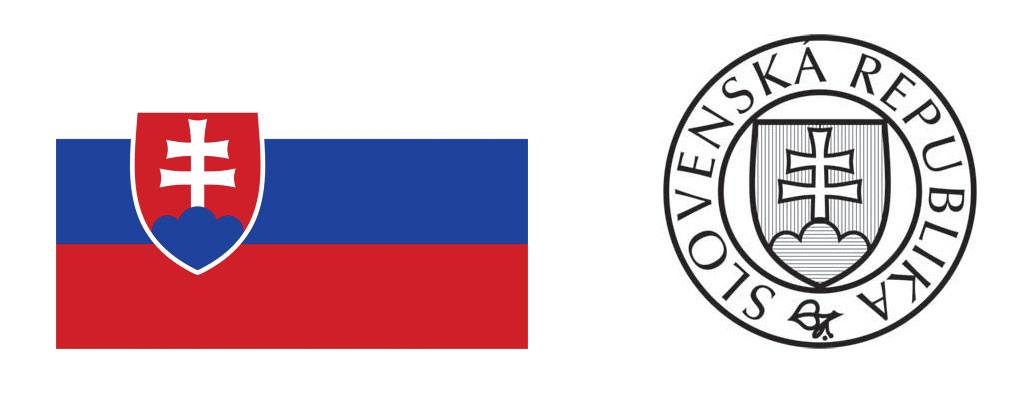Symbols
Slovak state symbols are the coat of arms, flag, seal and anthem Nad Tatrou sa blýska. They may be depicted, produced and used only in the manner stated by law.
The coat of arms comprises a double silver cross poised on the middle elevated peak of a three-peaked mountain on a red, Early Gothic shield. The middle part and arms of the cross are widened and cupped at their ends, the mountain peaks are rounded.
The flag consists of three horizontal bands, white, blue and red. They are equal in width and arranged below each other. The coat of arms is on the front half sheet of the flag. The coat of arms on the flag is an equal distance from the top, front and bottom edge of the flag and is half the height of the flag. There is a white edging, one hundredth of the width of the flag’s length, at places where the shield touches other colors than white. No contour line is used on the coat of arms of the flag. The ratio of the sides of the flag is 2:3.
The state seal is round. The coat of arms is depicted in its centre, and its colours are marked with heraldic hatchings. A circular inscription reading Slovenská republika runs around the seal. A linden leaf is depicted on the lower part of the seal. The diameter of the state seal is 45 mm.
The anthem is the first two stanzas of the song Nad Tatrou sa blýska.

Download:
Constitution of the Slovak Republic
Presidential fanfare
Slovak National Anthem (Vocal Version)
Slovak National Anthem (Vocal Version Without Music)
Slovak National Anthem (Wind Instruments Version)
Slovak National Anthem (Instrumental)
Slovak National Anthem (Musical Notes)
Currency
Slovakia introduced the euro currency as of 1 January 2009, becoming the 16th country of the eurozone, which represents an economic territory of the European Union. This territory encompasses the free trade area, the customs union among the EU countries, free movement of persons, capital, goods and services within the EU, coordination of economic policies among the EU countries and the single euro currency. The name “euro” was chosen by the heads of Member States or their respective governments at the Madrid European Council held in December 1995. Inspiration for the € symbol itself came from the Greek epsilon – a reference to the cradle of European civilisation – and the first letter of the word Europe.
With the permission of the European Community, the euro is also legal tender in several countries which had previously formed monetary unions with eurozone members. These include San Marino, Monaco and the Vatican. Based on an agreement with the European Community, these three states mint their own coins, with a state-specific design on their national (obverse) sides.
The central bank responsible for the European single currency is the European Central Bank, which determines the monetary policy for the eurozone countries. The ECB is based in Frankfurt am Main in Germany.
